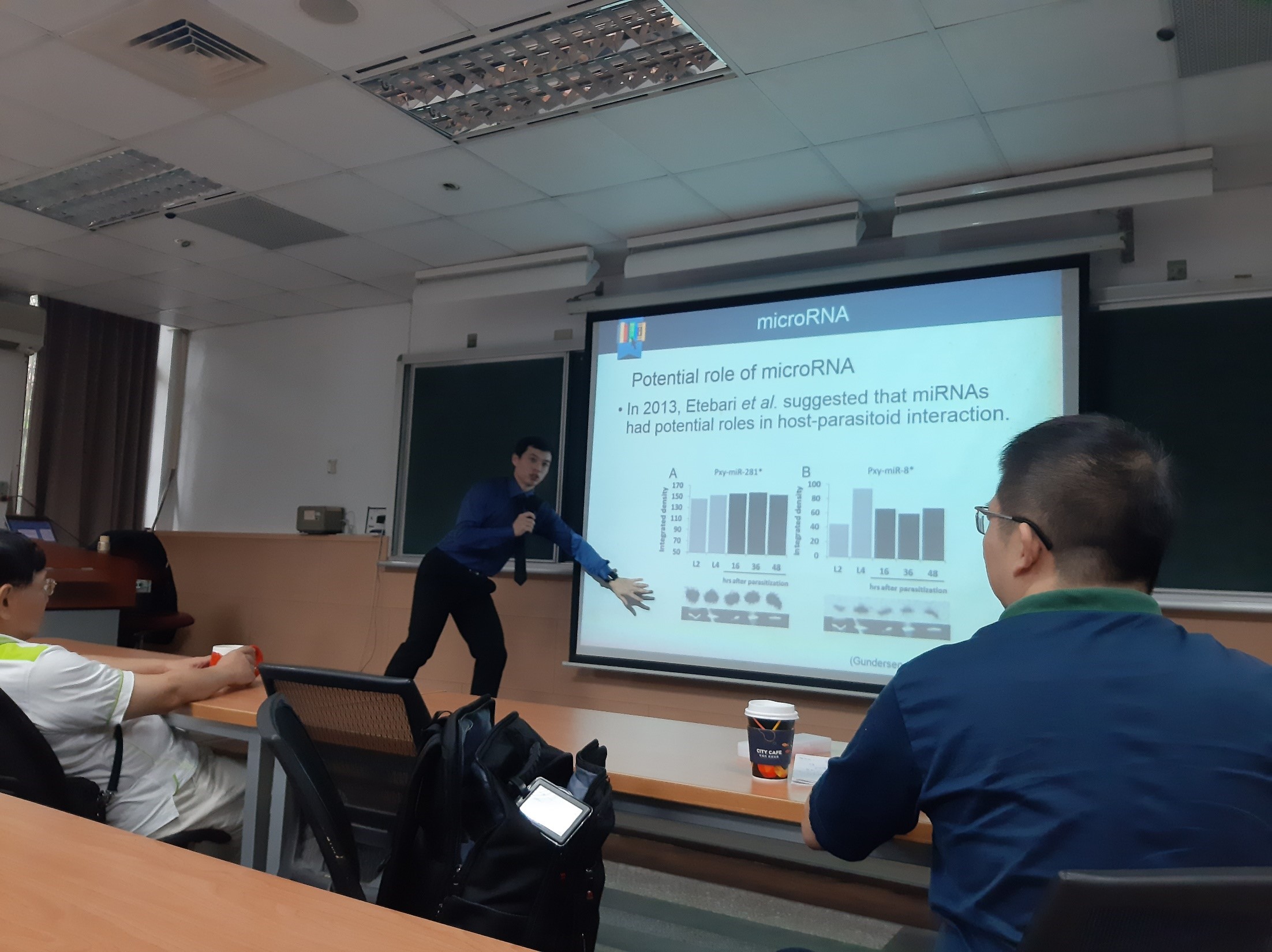講題 Polydnavirus – encoded microRNA exerts different effects on the immune responses in Spodoptera litura and Snellenius manila
演講者 Cheng-Kang Tang, Department of Entomology, National Taiwan University
小編 Sushanthi Poovendhan
主持人 Dr. Yueh-Lung Wu, Department of Entomology, National Taiwan University.
演講日期 2020/06/09 (二) 11:15~12:20
大綱 & 新知
Mr. Cheng-Kang Tang, a PhD in the near future has been an active researcher in the field of Insect Pathology. His talk dealing with the ‘Polydnavirus – encoded microRNA exerts different effects on the immune responses in Spodoptera litura and Snellenius manila’ was quite interesting to completely know about the story of parasitoid induced host defense and suppression reactions and how it is regulated by miRNAs. To begin with how the parasitoid S. manila, a parasitoid attacks the host S. litura is fascinating. S. manila is a parasitoid which belong to the order Hymenoptera and it prefers to lay eggs into the third instar larvae of S. litura which is a probable host. The interesting part is that, while laying eggs into the host, it also injects a Polydnavirus (Bracovirus) which comprises of multiple circular dsDNA. Thus, how does the host overcomes such an attack is the next big question! When a virus is introduced into the host, there occurs a series of events which includes: (1) Infection (invasion of pathogens) (2) Recognition by specific receptors (3) Reaction and (4) Induction of immune defense. As a result of this series of events, the host’s immune system could be suppressed. Moreover, the genome of PDV is composed of 70% non-coding and 30% coding regions, in which their main focus was the non-coding part. The first aim of their study was to emphasis on the energy transduction mechanism. They found that the SmBV was able to down-regulate the extracellular adenosine of its host, S. litura, to inhibit metabolism switching. They found that decreased carbohydrate mobilization, glycogenolysis, and ATP synthesis upon infection resulted in the host being unable to supply energy to its immune system, thus benefitting the development of wasp larvae.
Following this, their aim was to identify the role of miRNAs in the similar scenario. miRNAs are capable of assisting an insect in its development, enhancing of immune challenge, host-micobe interaction, stresses and in the functioning of endocrine system. miRNAs were previously identified in the wasp S. manila but its function on the host suppression has not been documented. However, 422 miRNAs have been known to be present in parasitized hosts. Among these, the miRNAs that were upregulated 10 times were chosen and the gene ontology studies related to immune system and physiology were studied. Interestingly, 11 miRNAs were identified to be related to the immune system. Stem-loop qPCR expression of those 11 miRNA candidates were carried out and it was narrow downed to 2 miRNAs that was found to be upregulated in both host and SL1A cells. They were miR-2989 and miR-199b-5p which had specific ability to be compared with the immune responses. Moreover, they also inhibited the humoral immunity pathway. In light of the RNAi technique, after mimics, these two miRNAs shut down the immune response genes. Furthermore, phagocytosis was performed to identify the inhibitors of these two miRNAs. As expected, the inhibitors were capable of rescuing the immune response and the same was validated through the physiological results in the larvae. This uncovered the functions of two SmBV-encoded miRNAs.
In addition, the role of histone deacetylase inhibitors (NaB) which could act as a potential novel therapeutic therapy to rescue honey bees from deformed wing virus was elucidated.
Overall, the work helps us to identify that miRNAs are potential players in regulating host immune responses and a complete knowledge of parasitoid wasps and the host interaction and their rescue mechanisms were obtained in detail.
Q&A
Q1: In your stem-loop qPCR expression result, miR3552 was also upregulated. Why was that not considered? (Sushanthi)
A1: Because miRNAs were chosen that was upregulated in both host and SL1A cells were considered and that miR3552 was not upregulated in the cells but only in the host. A possible explanation could be that the upregulation in the host might be due to other factors that were not related to the host immune response.
Key words : Spodoptera litura, Snellenius manila, miRNAs, host immune response, signal transduction, gene ontology, DWV, histone deacetylase inhibitor.
花絮照片3~5張 (Other photos):

(Mr. Tang emphasizing on the RNAi mimic and sponge technique of the two miRNAs)

(During an interactive session of Mr. Tang and Dr. Chun-Che Chang on the potential role of miRNAs)